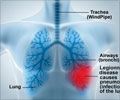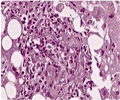The research design of and pilot data from the Pneumonia Etiology Research for Child Health (PERCH) Project is the focus of the March Special Supplement

"This supplement provides a unique opportunity to share our rigorous, deliberative and inclusive process in designing the PERCH study. We hope that our work can benefit other researchers and result in a greater degree of standardization in child pneumonia research," said Orin Levine, lead investigator on the study and professor of International Health at Johns Hopkins Bloomberg School of Public Health. "In learning more about the causes of pneumonia, we can design better treatments, diagnostics and vaccines to save children's lives."
PERCH, which is made possible by a grant from the Bill & Melinda Gates Foundation, will enroll up to 6,000 children 1-59 months old with severe or very severe pneumonia and a similar number of healthy children from seven selected study sites in order to understand the interplay between risk factors and infection by deadly viruses and bacteria. The seven study sites represent diverse geographic areas and disease ecologies that are expected to face the highest pneumonia disease burden in the coming decades and include Thailand, Bangladesh, The Gambia, Kenya, Mali, South Africa and Zambia.
PERCH was designed with the consultation of 16 external pneumonia experts over the course of 18 months. These experts informed the epidemiologic, clinical, laboratory and statistical design components of the study. Investigators from the seven study sites also contributed to the study design, and in addition ensured local relevance and feasibility.
The timing of PERCH is crucial as the pneumonia landscape has changed significantly since the last major multi-site research studies were conducted by the Board of Science and Technology for International Development (BOSTID) in the 1980s. Bacterial pathogens, especially Haemophilus influenzae and Streptococcus pneumoniae, were recognized to be the major etiologies of pneumonia mortality. Consequently, treatment and prevention strategies have focused primarily on targeting these agents. Since the BOSTID studies, the world has experienced the HIV pandemic, increased malaria control and a scaled up effort to introduce pneumococcal and Hib conjugate vaccines, as well as advancements in scientific technologies. The results of the PERCH study, strategically designed to reflect the expected epidemiological situation in 2015 and beyond, will provide important evidence to guide the next generation of pneumonia prevention and treatment approaches.
"As the world's epidemiologic settings change, we must stay ahead of the next challenge so we do not lose ground in the fight to reduce child mortality," said Dr. Katherine O'Brien, co-principal investigator of PERCH, and professor of International Health at Johns Hopkins. "PERCH will study and evaluate pneumonia and its causes using previously unavailable innovative and more sensitive diagnostic tools."
Advertisement
Results of the PERCH project are expected to become available in 2014. The study protocol, case report forms and standard operating procedures are available online at http://www.jhsph.edu/ivac/perch.html.
Advertisement
Collaborating institutions include: the University of Witwatersrand, Johannesburg and the National Institute for Communicable Diseases, Sandrigham, in South Africa; Kenya Medical Research Institute (KEMRI)-Wellcome Trust Research Programme in Kilifi, Kenya; Nuffield Department of Clinical Medicine, University of Oxford, Oxford, UK; Center for Vaccine Development, University of Maryland School of Medicine, Baltimore, MD, USA; Centre pour le Développement des Vaccins, Mali (CVD-Mali) in Bamako, Mali; the Thailand Ministry of Public Health; Centers for Disease Control and Prevention, Atlanta, Georgia, USA; Thailand Ministry of Public Health (MOPH) - U.S. Centers for Disease Control and Prevention (CDC) Collaboration in Nonthaburi, Thailand; Boston University Center for Global Health and Development, Boston, MA, USA; Boston University at the University Teaching Hospital of Lusaka, Zambia; the Medical Research Council Gambian Unit, Fajara and Basse, The Gambia; the International Centre for Diarrhoeal Disease Research, Bangladesh (ICDDR,B) in Dhaka, Bangladesh; the University of Otago and Canterbury Health Laboratories in Christchurch, New Zealand.
Source-Eurekalert















